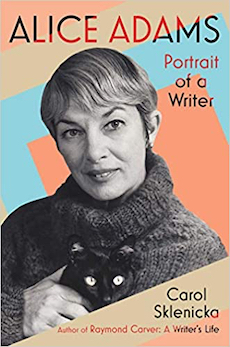By David Madden
“‘I am a beautiful girl,’ she rasps out furiously.’” That final line of her most famous short story “Beautiful Girl,” in her 1979 collection with the same title, tells the whole story of Alice Adams’ life and loves (34 men, she listed in her notebook).
Adams often said what Carol Sklenicka repeats as a fact that her eleven novels and five collections of stories are based intimately on her life. These titles are expressive of her childhood as “a Southern girl” in a dysfunctional family in Chapel Hill, North Carolina, her transplantation in California, and her ascendancy in New York City: Families and Survivors (1975), Southern Exposure (1995), Almost Perfect (1993), Superior Women (1984), and again, in summary, Beautiful Girl (1979).
Her mother was a sensuous intellectual; her father was an unlikable professor in the department of romance languages at UNC-Chapel Hill. Alice Adams became a doting but overwhelmed mother. A graduate of Radcliffe, she taught creative writing quite creatively at Chapel Hill and Stanford, where she had been a student of such courses.
Adams’ fiction, says Sklenicka, was mostly about “sex, romance, and love,” and she delineated the distinctions among those terms. She ends “Great Sex,” from her last book, The Last Lovely City (1999), this way: “They begin to kiss, and minutes later they have moved to Alison’s bedroom, where, on her bed, once more, they have great—the greatest sex.”
As early as her fourth book, this is how her voice sounds:
“At some point in the middle of that long night, Stella awakens from a dream—a dream of flowers, of lovely pale-pink plum blossoms on a dark twisted bow. She smiles to herself at the triteness, the corny metaphor, but that is what she dreamed. Of the loveliest flowers.”
According to Sklenicka, Alice Adams’ beauty was always a force in her sense of self and in her public reputation. What an elegant, classy lady on the literary scene in her time she must have been, among such luminaries as Diane Johnson, Alison Lurie, Laurie Colwin, Norman Mailer, Saul Bellow, and Joyce Carol Oates.
What happens to beauty in the course of the life of a beautiful woman happened to Alice Adams: when she was only 64, her beauty ceased to characterize her. Surgery for cancer in her sinuses disfigured her face and had a malignant effect on her morale until her death thirteen years later in 1999.
But what I am most eager to stress about the life and work of Alice Adams, who was so preoccupied with her beauty and its effects on men and women, is that she was always more preoccupied with the art of fiction, writing four more novels after the sinus operation.
Although I included her New Yorker story “New Best Friends” in The World of Fiction (1990), a textbook I edited, and invited her to give a reading at Louisiana State University in 1988, where she was singularly likable, I had to read Sklenicka’s biography to surmise that I must have been vaguely aware of her “unhappy passivity” in 1957 as the shadowy wife of Mark Linenthal, who was my friend on the creative writing faculty when I was a graduate student at San Francisco State. For more than forty years now, I have always thought of Alice Adams as living and writing in San Francisco.
California biographer Carol Sklenicka, author also of a biography of the minimalist short story writer Raymond Carver and of D. H. Lawrence and the Child (1991), dove so deep into Adams’ life as to come up with almost 600 enthralling pages and numerous intertextual photographs of a writer who deserves much more attention over the two decades since her demise.
David Madden (ΦBK, University of Tennessee) has published works in all genres, including novels and collections of short stories. The Voice of James M. Cain, an innovative biography, is his latest. My Creative Life in the Army is a memoir recently completed.




